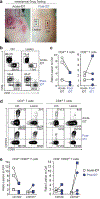Analysis of Skin-Resident Memory T Cells Following Drug Hypersensitivity Reactions
- PMID: 31883960
- PMCID: PMC7369252
- DOI: 10.1016/j.jid.2019.11.020
Analysis of Skin-Resident Memory T Cells Following Drug Hypersensitivity Reactions
Conflict of interest statement
Conflict of Interest Statement:
The authors state no conflict of interest
Figures

Similar articles
-
Participation of T lymphocytes in cutaneous allergic reactions to drugs.Clin Exp Allergy. 1998 Sep;28 Suppl 4:3-6. Clin Exp Allergy. 1998. PMID: 9761022 Review.
-
Skin Resident Memory T Cells May Play Critical Role in Delayed-Type Drug Hypersensitivity Reactions.Front Immunol. 2021 Aug 23;12:654190. doi: 10.3389/fimmu.2021.654190. eCollection 2021. Front Immunol. 2021. PMID: 34497600 Free PMC article. Review.
-
Nonimmediate reactions to betalactams.Curr Opin Allergy Clin Immunol. 2007 Aug;7(4):310-6. doi: 10.1097/ACI.0b013e3281e209fe. Curr Opin Allergy Clin Immunol. 2007. PMID: 17620822 Review.
-
Cutaneous adverse reaction of mogamulizumab, an anti-CC chemokine receptor 4 monoclonal antibody: Shared histopathological features with thymoma-associated multi-organ autoimmunity.J Dermatol. 2017 Jun;44(6):e117-e118. doi: 10.1111/1346-8138.13738. Epub 2016 Dec 27. J Dermatol. 2017. PMID: 28026038 No abstract available.
-
[Mechanisms of cutaneous drug reactions].J Dtsch Dermatol Ges. 2004 Dec;2(12):1013-23; quiz 1024-6. doi: 10.1046/j.1439-0353.2004.04524.x. J Dtsch Dermatol Ges. 2004. PMID: 16285316 Review. German. No abstract available.
Cited by
-
Systemic and skin-limited delayed-type drug hypersensitivity reactions associate with distinct resident and recruited T cell subsets.J Clin Invest. 2024 Jul 23;134(17):e178253. doi: 10.1172/JCI178253. J Clin Invest. 2024. PMID: 39042477 Free PMC article.
-
Blister fluid as a cellular input for ex vivo diagnostics in drug-induced severe cutaneous adverse reactions improves sensitivity and explores immunopathogenesis.J Allergy Clin Immunol Glob. 2021 Nov 30;1(1):16-21. doi: 10.1016/j.jacig.2021.11.001. eCollection 2022 Feb. J Allergy Clin Immunol Glob. 2021. PMID: 37780076 Free PMC article.
-
Skin infiltrating T-cell profile of drug reaction with eosinophilia and systemic symptoms (DRESS) reactions among HIV-infected patients.Front Med (Lausanne). 2023 May 5;10:1118527. doi: 10.3389/fmed.2023.1118527. eCollection 2023. Front Med (Lausanne). 2023. PMID: 37215719 Free PMC article.
-
Drug Reaction with Eosinophilia and Systemic Symptoms (DRESS): Focus on the Pathophysiological and Diagnostic Role of Viruses.Microorganisms. 2023 Jan 30;11(2):346. doi: 10.3390/microorganisms11020346. Microorganisms. 2023. PMID: 36838310 Free PMC article. Review.
-
Updates on the immunopathology and genomics of severe cutaneous adverse drug reactions.J Allergy Clin Immunol. 2023 Feb;151(2):289-300.e4. doi: 10.1016/j.jaci.2022.12.005. J Allergy Clin Immunol. 2023. PMID: 36740326 Free PMC article. Review.
References
-
- Aithal GP, Watkins PB, Andrade RJ, Larrey D, Molokhia M, Takikawa H, et al. Case definition and phenotype standardization in drug-induced liver injury. Clin Pharmacol Ther 2011;89(6):806–15. - PubMed
-
- Gamradt P, Laoubi L, Nosbaum A, Mutez V, Lenief V, Grande S, et al. Inhibitory checkpoint receptors control CD8(+) resident memory T cells to prevent skin allergy. J Allergy Clin Immunol 2019;143(6):2147–57 e9. - PubMed
-
- Gebhardt T, Wakim LM, Eidsmo L, Reading PC, Heath WR, Carbone FR. Memory T cells in nonlymphoid tissue that provide enhanced local immunity during infection with herpes simplex virus. Nat Immunol 2009;10(5):524–30. - PubMed
-
- Iriki H, Adachi T, Mori M, Tanese K, Funakoshi T, Karigane D, et al. Toxic epidermal necrolysis in the absence of circulating T cells: a possible role for resident memory T cells. J Am Acad Dermatol 2014;71(5):e214–6. - PubMed
Publication types
MeSH terms
Substances
Grants and funding
LinkOut - more resources
Full Text Sources
Medical

